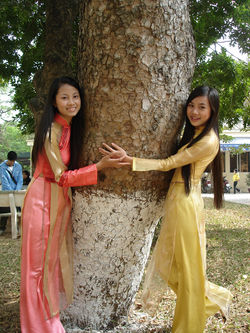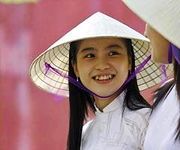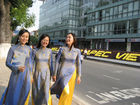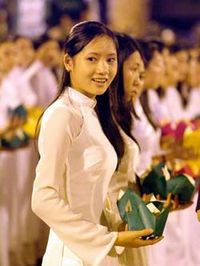Aodai

The ao dai (áo dài) is a Vietnamese national costume, now most commonly for women. In its current form, it is a tight-fitting silk tunic worn over pantaloons. The word is pronounced [ǎːwzâːj], approximately ow-zye, in the North, and with a y sound for the d in the South. Áo is derived from a Middle Chinese word meaning "padded coat" (襖).[1] Dài means "long".[1]
The word "ao dai" was originally applied to the outfit worn at the court of the Nguyễn Lords at Huế in the 18th century. This outfit evolved into the áo ngũ thân, a five-paneled aristocratic gown worn in the 19th and early 20th centuries. Inspired by Paris fashions, Nguyễn Cát Tường and other artists associated with Hanoi University redesigned the ngũ thân as a modern dress in the 1920s and 1930s.[2] The updated look was promoted by the artists and magazines of Tự Lực văn đoàn ("Self-Reliant Literary Group") as a national costume for the modern era. In the 1950s, Saigon designers tightened the fit to produce the version worn by Vietnamese women today.[2] The dress was extremely popular in South Vietnam in the 1960s and early 1970s. The Communist Party, which has ruled Vietnam since 1975, for a time disapproved of the dress and promoted frugal, androgynous styles.[3] In the 1990s, the ao dai regained popularity.[3] On Tết and other occasions, Vietnamese men may wear an áo gấm "(brocade robe)", a version of the ao dai made of thicker fabric.
Academic commentary on the ao dai emphasizes the way the dress ties feminine beauty to Vietnamese nationalism, especially in the form of "Miss Ao Dai" pageants, popular both among overseas Vietnamese and in Vietnam itself.[4] "Ao dai" is one of the few Vietnamese words that appear in English-language dictionaries.[nb 1]
Contents |
Parts of dress
- Nút bấm thân áo: hooks (used as fasteners) and holes
- ống tay: sleeve
- Đường ben: inside seam
- Nút móc kết thúc: main hook and hole
- Tà sau: back flap
- Khuy cổ: collar button
- Cổ áo: collar
- Đường may: seam
- ống tay: sleeve
- Kích (eo): waist
- Tà trước: front flap
The ao dai can be worn with a nón lá (pointed leaf hat), a style associated with Huế. On weddings and other formal occasions, a circular headgear called a khăn đóng is worn.
History

18th century
Peasant women typically wore a halter top (áo yếm) underneath a blouse or overcoat, that was paired with a skirt (váy).[5] Influenced by the fashions of China's imperial court, aristocrats favored less revealing clothes.[6] In 1744, Lord Nguyễn Phúc Khoát of Huế decreed that both men and women at his court wear trousers and a gown with buttons down the front.[2][nb 2] Writer Lê Quý Đôn described the newfangled outfit as an áo dài (long shirt).[nb 3] The members of the southern court were thus distinguished from the courtiers of the Trịnh Lords in Hanoi, who wore a split-sided jacket and a long skirt.[7]
19th century
The áo tứ thân, a traditional four-paneled gown, evolved into the five-paneled áo ngũ thân in the early 19th century.[7] Ngũ is Sino-Vietnamese for "five." It refers not only to the number of panels, but also to the five elements in oriental cosmology. The áo ngũ thân had a loose fit and sometimes had wide sleeves. Wearers could display their prosperity by putting on multiple layers of fabric, which at that time was costly. Despite Vietnam's tropical climate, northern aristocrats were known to wear three to five layers.
The áo ngũ thân had two flaps sewn together in the back, two flaps sewn together in the front, and a "baby flap" hidden underneath the main front flap. The gown appeared to have two-flaps with slits on both sides, features preserved in the later ao dai. Compared to a modern ao dai, the front and back flaps were much broader and the fit looser. It had a high collar and was buttoned in the same fashion as a modern ao dai. Women could wear the dress with the top few buttons undone, revealing a glimpse of their yếm underneath.
Present day
No longer controversial politically, ao dai fashion design is supported by the Vietnamese government.[7] It often called the áo dài Việt Nam to link it to patriotic feeling. Designer Le Si Hoang is a celebrity in Vietnam and his shop in Ho Chi Minh City is the place to visit for those who admire the dress.[7] In Hanoi, tourists get fitted for ao dai on Luong Van Can Street.[8] The elegant city of Huế in the central region is known for its ao dai, nón lá (leaf hats), and well-dressed women.
The ao dai is now standard for weddings, for celebrating Tết and for other formal occasions. A plain white ao dai is a common high school school uniform in the South. Companies often require their female staff to wear uniforms that include the ao dai, so flight attendants, receptionists, restaurant staff, and hotel workers in Vietnam may be seen wearing it.

The most popular style of ao dai fits tightly around the wearer's upper torso, emphasizing her bust and curves. Although the dress covers the entire body, it is thought to be provocative, especially when it is made of thin fabric. "The ao dai covers everything, but hides nothing", according to one saying.[9] The dress must be individually fitted and usually requires several weeks for a tailor to complete. An ao dai costs about $200 in the United States and about $40 in Vietnam.[10]
"Symbolically, the ao dai invokes nostalgia and timelessness associated with a gendered image of the homeland for which many Vietnamese people throughout the diaspora yearn", wrote Nhi T. Lieu, an assistant professor at the University of Texas at Austin.[4] The difficulties of working while wearing an ao dai link the dress to frailty and innocence, she wrote.[4] Vietnamese writers who favor the use of the ao dai as a school uniform cite the inconvenience of wearing it as an advantage, a way of teaching students feminine behavior such as modesty, caution, and a refined manner.[11]
The ao dai is featured in an array of Vietnam-themed or related movies. In Good Morning Vietnam (1987), Robin Williams's character is wowed by ao dai-clad women when he first arrives in Saigon. The 1992 films Indochine and The Lover inspired several international fashion houses to design ao dai collections,[12] including Prada's SS08 collection and a Georgio Armani collection. In the Vietnamese film The White Silk Dress (2007), an ao dai is the sole legacy that the mother of a poverty-stricken family has to pass on to her daughters.[13] The Hanoi City Complex, a 65-story building now under construction, will have an ao dai-inspired design.[14] Vietnamese designers created ao dai for the contestants in the Miss Universe beauty contest, which was held July 2008 in Nha Trang, Vietnam.[15]
Gallery
 A Nguyen Dynasty princess in ao dai |
Dancing high school students |
 Hanoi during APEC summit |
 Our Lady, |
 Graduation |
 Contemporary ao dai designs |
 Wikipe-tan wearing ao dai |
See also
- Culture of Vietnam
- History of Vietnam
- Qipao
- Vietnamese clothing
Notes
Footnotes
- ↑ "Ao dai" appears in the Oxford English Dictionary, the American Heritage Dictionary (2004), and the Random House Unabridged Dictionary (2006). Other Vietnamese words that appear include "Tết", "Viet", "Vietminh", and "Vietcong". "Pho" (rice noodles) was added to the Shorter Oxford Dictionary in 2007.[1]
- ↑ A court historian described the dress in Huế as follows: Outside court, men and women wear gowns with straight collars and short sleeves. The sleeves are large or small depending on the wearer. There are seams on both sides running down from the sleeve, so the gown is not open anywhere. Men may wear a round collar and a short sleeve for more convenience. "Thường phục thì đàn ông, đàn bà dùng áo cổ đứng ngắn tay, cửa ống tay rộng hoặc hẹp tùy tiện. Áo thì hai bên nách trở xuống phải khâu kín liền, không được xẻ mở. Duy đàn ông không muốn mặc áo cổ tròn ống tay hẹp cho tiện khi làm việc thì được phép ..." (from Đại Nam Thực Lục [Records of Đại Nam])
- ↑ Lê Quý Đôn, Phủ Biên Tạp Lục [Frontier Chronicles] (1775-76), Lord Nguyễn Phúc Khoát wrote the first page in the history of the áo dài (襖長). "Chúa Nguyễn Phúc Khoát đã viết những trang sử đầu cho chiếc áo dài như vậy".
Citations
- ↑ 1.0 1.1 "ao dai", American Heritage Dictionary. Retrieved on 2 July 2008.
- ↑ 2.0 2.1 2.2 Ellis, Claire (1996), "Ao Dai: The National Costume", Things Asian, http://www.thingsasian.com/stories-photos/1083, retrieved 2008-07-02.
- ↑ 3.0 3.1 Leshkowich, Ann Marie (2003), "The Ao Dai Goes Global: How International Influences and Female Entrepreneurs have shaped Vietnam's "National Costume"", Re-orienting Fashion: The Globalization of Asian Dress (Berg Publishers): 93, ISBN 9781859735398, http://books.google.com/?id=1G7KvEozkuUC.
- ↑ 4.0 4.1 4.2 Lieu, Nhi T., "Remembering 'The Nation' through Pageantry: Femininity and the Politics of Vietnamese Womanhood in the 'Hoa Hau Ao Dai' Contest", Frontiers: A Journal of Women's Studies Vol. 21, No. 1/2, Asian American Women (2000), pp. 127–151. University of Nebraska Press
- ↑ Leshkowich, p. 89.
- ↑ Leshkowich, p. 90.
- ↑ 7.0 7.1 7.2 7.3 Valverde, Caroline Kieu (2006), "The History and Revival of the Vietnamese Ao Dai", NHA magazine, http://www.nhamagazine.com/back_issue/issue_0506/ac_p1.shtml, retrieved 2008-07-02.
- ↑ "Traditional ao dai grace foreign bodies". VNS. December 20, 2004. http://web.archive.org/web/*/http://vietnamnews.vnagency.com.vn/2004-12/18/Stories/33.htm. Retrieved July 29, 2008.
- ↑ "Vietnamese AoDai". Overlandclub. http://www.overlandclub.jp/en/info/vn_aodai.html. Retrieved July 2, 2008.
- ↑ "Ao Dai Couture", Nha magazine., http://www.nhamagazine.com/012008/feature/aodai.shtml, retrieved August 12, 2008
- ↑ Leshkowich p. 97.
- ↑ Ao Dai — Vietnamese Plus Size Fashion Statement, http://articles.getacoder.com/Ao_Dai_-_Vietnamese_Plus_Size_Fashion_Statement_808529x1200042917.htm, retrieved July 14, 2008
- ↑ "Vietnam send Ao Lua Ha Dong to Pusan Film Festival", VietNamNet Bridge, 2006, http://vietq.wordpress.com/2006/10/16/vietnam-send-ao-lua-ha-dong-to-pusan-film-festl/, retrieved July 13, 2008
- ↑ Tuấn Cường. ""Nóc nhà" Hà Nội sẽ cao 65 tầng" (in Vietnamese). Tuoi Tre. http://www.tuoitre.com.vn/Tianyon/Index.aspx?ArticleID=192066&ChannelID=3. Retrieved 2009-04-26.
- ↑ "Miss Universe contestants try on ao dai", Vietnam.net Bridge, 2008, http://english.vietnamnet.vn/lifestyle/2008/06/789353/, retrieved 2008-07-02.
External links
- Creative Pictures of Ao Dai. Ao Dai.
- Ao Dai - Vietnamese Traditional Dress - A high quality online Flash album.
- Ao Dai - Soul of Vietnam. The history of the ao dai in photos.
- Ao Dai Project. More photos. Less history and more makeup.
- Ao Dai - The Traditional Vietnamese Dress. A video showing various styles of ao dai.
- History Of VN Long Dress.
- The Ao Dai Blog. The latest in ao dai-related news.
- The Evolution of the Ao Dai Through Many Eras, Gia Long Alumni Association of Seattle, 2000.
- Vietnam: Mini-Skirts & Ao-Dais. A video that shows what the women of Saigon wore in 1968.
- Fashion Ao Dai. A blog about Ao Dai.
|
||||||||||||||||||||||||||||||||||||||||||||||||||||||||